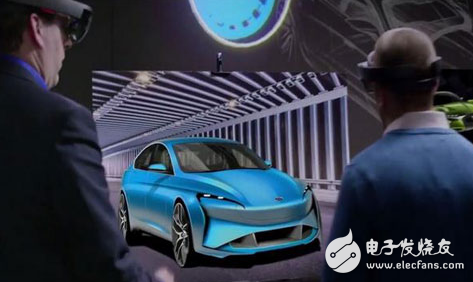Since the introduction of holographic lens technology by Microsoft in 2016, this groundbreaking innovation has sparked widespread interest across industries. Companies like ThyssenKrupp have applied it to elevator design, NASA has used it to simulate Martian terrain, and Case Western Reserve University has incorporated it into anatomy education. Now, Ford Motor Company is also exploring the integration of augmented reality (AR) into its vehicle development process, though no specific model has been officially announced yet.
Ford is expanding its use of Microsoft Holographic Lens mixed reality headsets in automotive design, aiming to speed up the development of new vehicles through AR. Each wireless headset costs around $5,000, allowing designers to overlay digital car models onto real-world prototypes. This enables them to adjust components like headlights or lower the hood after modifying the shape, streamlining the design process significantly.

If a designer wants to make changes to a specific part of the car, they can simply record their thoughts in voice notes, which other team members can later review and evaluate. This collaborative approach enhances communication and decision-making.
Jim Holland, Vice President of Ford Auto Parts and Systems Engineering, emphasized the benefits of combining traditional methods with modern tech: "It's surprising how well old and new skills—like clay models and holograms—can work together. It saves time and makes the design process more intuitive. Microsoft’s holographic lens technology is a powerful tool for our designers, helping us stay innovative in a fast-paced world."
Ford officials stress that the technology isn’t meant to replace traditional tools such as clay models or CAD software. Instead, it complements them by enabling faster design decisions and quicker time-to-market. According to the company, the new system can reduce design decision-making time by hours or even weeks.
Elizabeth Baron, Ford’s VR and high-end visualization technology expert, added, "Holographic lenses allow the entire team to collaborate, share, and experience each design proposal in real-time. Mixed reality combined with physical models helps improve communication between designers and engineers, making the development of the car’s architecture more efficient and exciting."
The headsets run on Windows 10, and access is restricted to invited users for security purposes. This ensures that only authorized personnel can view and interact with the virtual designs.
One of the biggest advantages of the technology is that multiple people can see the same 3D virtual image simultaneously. For example, designers in China can view changes made by engineers in Michigan, breaking down geographical barriers and improving global collaboration.
Microsoft first introduced holographic lens technology in 2016, and since then, many companies have adopted it for various commercial applications. From elevator design to space exploration and medical education, the potential of this technology continues to grow.
Ford has been researching the use of holographic lenses for several years, and while the company hasn’t revealed which models will use the technology, it’s clear that the future of automotive design is becoming increasingly digital and immersive.
USB4 Cable
USB4 specifies tunneling of:
USB 3.2 ("Enhanced Superspeed") Tunneling
DisplayPort 1.4a -based Tunneling
PCI Express (PCIe)-based Tunneling
Main Benefits of USB 4
The new USB 4 standard has three main benefits over prior versions of USB.
40 Gbps Maximum Speed: By using two-lane cables, devices are able to operate at up to 40 Gbps, the same speed as Thunderbolt 3. The data is transmitted in two sets of four bidirectional lanes.
DisplayPort Alt Mode 2.0: USB 4 supports DisplayPort 2.0 over its alternative mode. DisplayPort 2.0 can support 8K resolution at 60 Hz with HDR10 color. DisplayPort 2.0 can use up to 80 Gbps, which is double the amount available to USB data, because it sends all the data in one direction (to the monitor) and can thus use all eight data lanes at once.
Compatible with Thunderbolt 3 devices: Some, but not necessarily all USB 4 implementations will also work with Thunderbolt 3 devices.
Better Resource Allocation for Video, PCIe: In lieu of alternative mode where the other interface takes over the connection, USB 4 devices can use a process called "protocol tunneling" that sends DisplayPort, PCIe and USB packets at the same time while allocating bandwidth accordingly.
Usb4 Cable,Usb To Usb4,Usb 4 Cable,Usb 4 Wires
UCOAX , https://www.ucoax.com